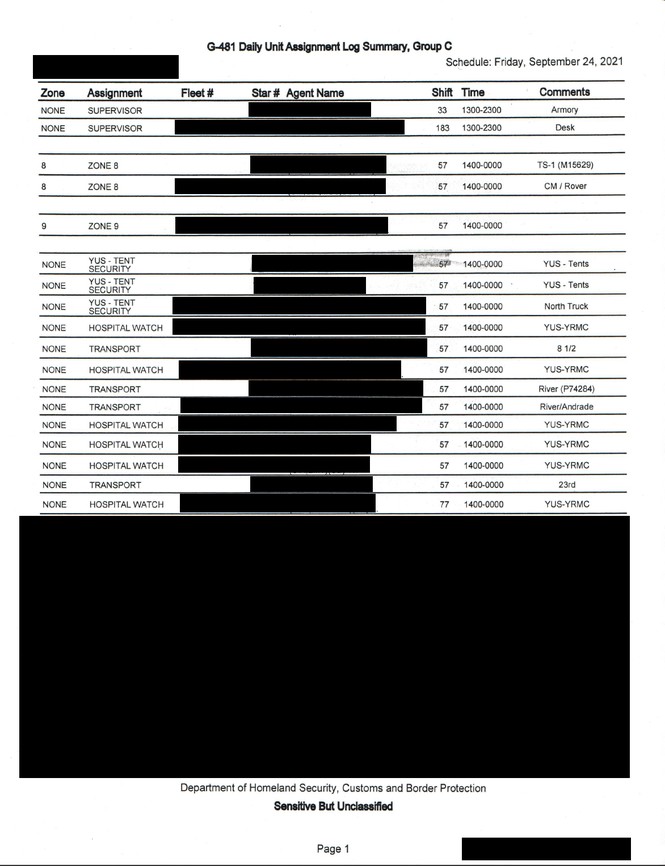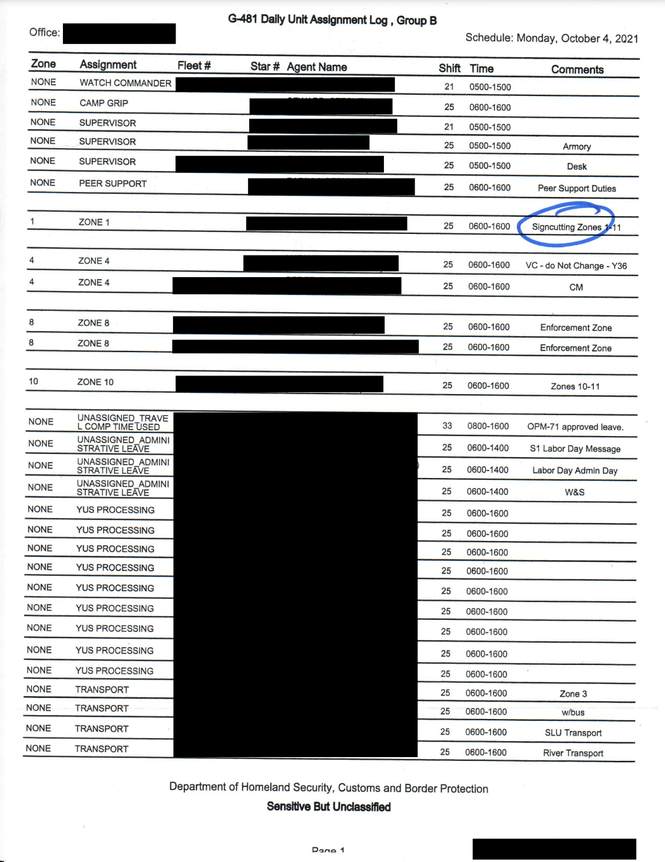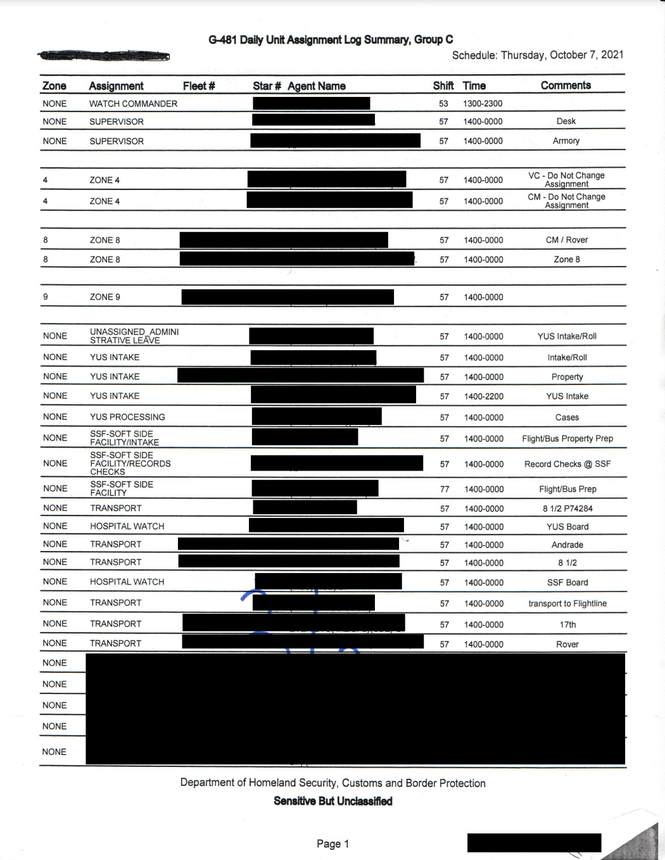Border Patrol daily assignment rosters in the Yuma Sector, obtained exclusively by Townhall, show how open the U.S.-Mexico border has become in the area as many agents — instead of patrolling the international border — are assigned to either process the thousands of illegal immigrants who willingly give themselves up to seek asylum or transport the large groups of people from the border to the sector's headquarters.
The documents, which span several weeks of assignments for Yuma Station, provide a rare insight into the daily operations for a sector that experienced a 584 percent increase in single adult encounters, a 242 percent increase in family unit encounters, and a 237 percent increase in unaccompanied children encounters during fiscal year 2021 compared to fiscal year 2020. The assignment logs, which were given to Townhall unedited except to show who was on patrol and who was on field processing, have been blacked out to protect the identities of the Border Patrol agents. They did not include the assignments for agents working at Blythe Station or Wellton Station.
The documents show that when one to four agents are assigned to patrol the southern border, they are often placed near the San Luis Port of Entry or have to cover multiple zones by themselves. Prior to this year's surge, it was explained to Townhall that most of the zones would be covered by at least one agent, depending on if there was a wall and the manpower for the day.
The logs reveal, depending on the day and shift, more agents are assigned to actions such as transport, processing, or hospital watch, where they guard illegal immigrants taken to local hospitals, instead of patrolling the border.
"Border Patrol no longer does border enforcement. It does border enrollment," a source said.
Recommended
For September 24 during the 14:00-00:00 shift:
- Two agents were assigned to patrol.
- One agent was assigned to field processing.
- Three agents were security for the processing facility.
- Four agents were assigned to transport.
- Six agents were assigned to hospital watch.

For October 4 during the 06:00-16:00 shift:
- Three agents were assigned to patrol.
- Two agents were assigned to field processing.
- Four agents were assigned to transport.
- Nine agents were assigned to processing at the holding facility.
- One agent was given the "signcutting" assignment, which is where they try to track how many "gotaways" the sector had during the night.

For October 7 during the 14:00-00:00 shift:
- Three agents were assigned to patrol.
- Two agents were assigned to field processing.
- Six agents were assigned to transport.
- Seven agents were given different assignments relating to processing.
- Two agents were assigned hospital watch.

Other days, such as October 13 and October 14 during the 06:00-16:00 shifts, had as many as six agents assigned to patrol, still well under normal pre-2021 surge numbers. October 13 had seven agents for processing and five for transport during the same shift.
The daily rosters obtained by Townhall do not include the dates before the significant surge in illegal immigrants coming into Yuma in early December. While I was in Yuma for Townhall during that time period, I was able to see firsthand how zero agents were on patrol along the Colorado River. Border Patrol transport vans were deployed but ordered to stay away from the levee road until they were told to pick up groups for processing, meaning no one in law enforcement was consistently watching the groups after they crossed into the country. This resulted in groups of illegal immigrants walking into Yuma's city limits unimpeded.
"I remember when Trump was president, illegal aliens used to hide from the Border Patrol," the same source told Townhall. "Now the Border Patrol has to hide from them."
Similar to yesterday although a smaller group, some Colombians decided to leave the border wall area and head into Yuma to find the Border Patrol station. pic.twitter.com/b0nI67V2H1
— Julio Rosas (@Julio_Rosas11) December 9, 2021
When the "all hands on deck" approach to processing illegal immigrants started in early August, "we were at zero people patrolling. That lasted until that lady and her child died along the river."
The source was referring to the case of Claudia Marcela Pineda Sarmiento and her two children. 12News reported it was 1 p.m. and 113 degrees outside when Pineda Sarmiento got lost in the Cocopah Indian Reservation after crossing into the United States in late August. Pineda Sarmiento, who was trying to get to Florida where her husband lived, called 911 when her cell phone was at three percent battery. The call was rerouted to Border Patrol's Yuma Sector. U.S. Customs and Border Protection's (CBP) Air and Marine Operations (AMO) Yuma Air and Marine Branch and agents were dispatched to locate the family.
Agents found Pineda Sarmiento's body two hours later. Her 22-month-old son, Krysthyan, was alive by her side, but it took another hour before they were able to find the body of 10-year-old Maria Jose Sanchez Pineda. The fact Maria was away from her mother indicates Pineda Sarmiento died first before Maria wandered off.
"I have no doubt that they would have survived" if more agents had been assigned to patrol, the source said, pointing to how Pineda Sarmiento was found not far from a road that agents normally patrolled before this year's surge in illegal crossings.
"I've never seen so many people die in one year along the border. This is the worst it's ever been and the number of entries is increasing. The deaths will spike again, there is no end in sight and the Yuma summer heat is coming again."
Efforts to bolster patrol numbers included using Border Patrol K-9 units and members of the Border Patrol Tactical Unit (BORTAC), but that was a temporary fix. The lack of manpower at the border became so dire in the Yuma Sector that Border Patrol told local law enforcement during a muster in December they would be relying on them to do border-enforcement type work since their agents would be unable to do it.
Miles of the border being unguarded by Border Patrol due to the influx of large groups illegally crossing into the U.S. is not unique to the Yuma Sector. When tens of thousands of Haitians crossed into Texas' Del Rio Sector in September, over two hundred miles of the southern border were not being patrolled by agents because all manpower was being dedicated to the makeshift camp under the international bridge.
"Under President Biden, there is no point in having a Border Patrol. He has refused to implement policy that allows for the proper protection of our borders and our citizens. President Biden’s policies are allowing criminal cartels to dictate the Border Patrol’s operations. President Biden has ceded control of our borders to criminals," Brandon Judd, president of the National Border Patrol Council, told Townhall in response to the documents.
Requests for comment given to the Yuma Sector's Public Affairs Office were not returned in time for publication.
John Mennell, the supervisory public affairs specialist for CBP Public Affairs in Arizona, provided the following statement after I reached out to the Department of Homeland Security about the assignment logs:
Unscrupulous smugglers continue to exploit vulnerable migrants. CBP’s message is clear: Our borders are not open. People should not make the dangerous journey. DHS continues to expel migrants under CDC’s Title 42 authority. Individuals who are not able to be expelled are processed through the Department’s Title 8 immigration authorities for either expedited or full removal proceedings.
CBP is currently managing the effects on Yuma Sector of the exploitation on those vulnerable populations and is working with our partners in a whole of government approach to expeditiously transport, screen and process those encountered. Local non-governmental organizations continue to assist in providing basic needs for the migrants still waiting to be taken into custody along the border.
CBP deploys Border Patrol agents and CBP officers as needed to support operations based on fluctuations as necessary. Our borders are not open. CBP stands read to address any scenario as we work to ensure the safety and security of our borders, and to manage a fair and orderly immigration system.
CBP plans for all possible scenarios based off information on the operations of smugglers or movements of migrants. Our posture and response are based on comprehensive analysis, and not on any single report. CBP stands ready to address any potential increase in migrant encounters as we work to ensure safety and security of our borders, while managing a fair and orderly immigration system.


